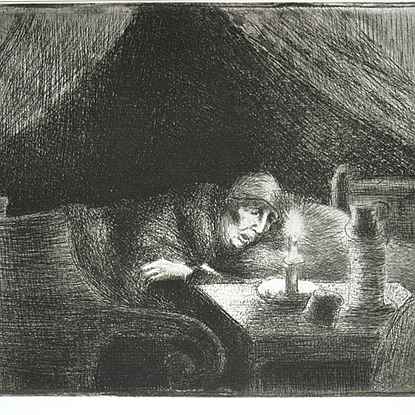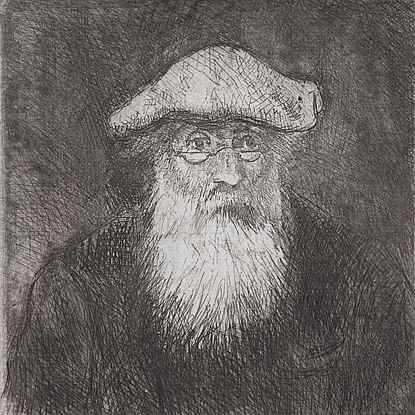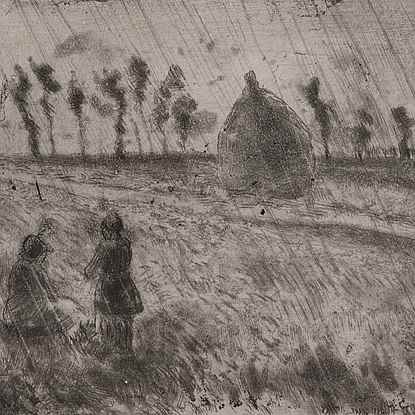Camille Pissarro (1830 - 1903)
Bords de l’Oise, Environs de Pontoise
Request Viewing
Oil on canvas
33 x 41 cm (13 x 16 ¹/₈ inches)
Signed and dated lower right, C. Pissarro 1872
-
Provenance
Hector Brame, Paris
Galerie Durand-Ruel, Paris, acquired from the above, 24th October 1921
Terves, acquired from the above, 1st March 1924
Bruno Stahl, Berlin, placed in storage at the Wildenstein Gallery, Paris
Confiscated with other artworks belonging to Georges Wildenstein from the gallery by the Einsatzstab Reichsleiter Rosenberg (ERR) in occupied Paris and transferred to the Jeu de Paume, Paris
Transferred to Lager Peter in Altaussee, Austria, 15th January 1943
Transferred to the Central Collecting Point, Munich, 20th June 1945 (inv. no. 212/21)
Repatriated to France on 18th April 1946
Restituted to Georges Wildenstein on 21st March 1947 and returned to Bruno Stahl
Wildenstein & Co., Inc., New York, acquired from the above, January 1949
Jacques Guerlain, Paris, acquired from the above, 1951
Private collection, France, acquired from the above -
Exhibitions
Paris, Galerie Durand-Ruel, Pissarro (1830-1903), 1956, no. 11
Stern Pissarro Gallery, London, Camille Pissarro: Works from the Gallery Collection, 30th November - 11th December 2021, p.29 (illustrated)
-
Literature
A. Tabarant, Pissarro, Paris, 1924, pl. 13
L-R. Pissarro & L. Venturi, Camille Pissarro Son Art-Son Oeuvre, Paris, 1939, vol. I, catalogued no. 161, p. 102; vol. II, no. 161, pl. 32
G. Jedlicka, Pissarro, Bern, 1950, pl. 8
T. Natanson, Pissarro, Lausanne, 1950, pl. 8
R. Brettell, Pissarro and Pontoise, the Painter in a Landscape, 1990, referenced on p. 158
J. Pissarro & C. Durand-Ruel Snollaerts, Pissarro, Catalogue Critique des Peintures, vol. II, Paris, 2005, p. 218, no. 274 (illustrated)
-
Description
Painted in 1872, Bords de l’Oise, environs de Pontoise is both a wonderful example of early Impressionism and a testament to Pissarro’s desire to paint a true portrait of contemporary France.
Having originally visited the area of Pontoise in the 1860s, Camille returned there in 1872 and made it his home over the following decade. It was here that Pissarro received his artist friends, including Paul Cézanne and Paul Gauguin, whom he taught to paint in the Impressionist style. When the artist arrived, the town was flourishing; from the rural tranquillity of the surrounding countryside to the bustling activity of the busy riverside, the town presented Pissarro with a wealth of possible subjects. Throughout his stay, the artist executed around 300 paintings, as well as numerous gouaches, pastels, drawings and prints.
In the present work, Pissarro captures a view of the Oise River that reveals the effects of modernity on the landscape. The two barges, one moored in the foreground and the other mid-river, are placed against a backdrop in which the distinctive silhouette of a factory chimney dominates the horizon. Pissarro was evidently intrigued by the idea of showing industrial features within a more rural setting, returning to paint similar scenes the following year.
Pissarro was fascinated by the symbols of the developing urban landscape, whether in the form of the new Parisian boulevards or the factory chimneys and smoke present in Bords de l’Oise. While his interest in depicting the changing face of France is at the heart of this work, the painting also celebrates the nuances of atmosphere, weather, and light, which he could promptly capture by painting en plein air. Pissarro skilfully juxtaposes the solidity of the boats against a broad sweep of sky that is reflected in the river beneath. Painted with small, deft brushstrokes, Bords de l’Oise, environs de Pontoise masterfully renders a sense of transience within this riverside scene.
This original painting by Camille Pissarro is available for sale.
Artist's Biography
Camille Pissarro was one of the most influential members of the French Impressionist movement. Born 10th July 1830 in the Danish colony of Saint Thomas, Camille was the son of Frédéric and Rachel Pissarro. At the age of twelve he went to school in Paris, where he displayed a penchant for drawing. With his parents disapproving of his interest in art, Camille left the island in 1852 with a Danish artist Fritz Melbye to spend the next 18 months in Venezuela. After a brief return to St. Thomas he moved to Paris in 1855 to study at the Académie Suisse where he would meet many influential artistic figures of the period, including Claude Monet, Paul Cézanne, Édouard Manet and Pierre-Auguste Renoir.
In 1869 Camille moved to Louveciennes. The outbreak of the Franco-Prussian War in 1870 prompted him to relocate to London, where Camille painted a series of landscapes around Norwood and Crystal Palace. At this time, Pissarro and his close friend Claude Monet were able to visit museums together, where they could study and expand their understanding of the tradition of British landscape painting. It was also here that he married Julie Vellay, with whom he would have seven children. Upon returning in June 1871 to Louveciennes, Camille discovered that many of the works he had left in his house had disappeared or become damaged during the Franco-Prussian war.
Camille settled in Pontoise with Julie in the summer of 1871 where he was able to gather a close circle of friends around him for the next ten years. Here he was able to continue building his relationships with Cézanne, Monet, Renoir and Degas, expressing his desire to create an alternative to the Salon. This represented a longing to break from the rigid tradition of French academic painting – Camille believed that he and his peers deserved recognition for the new tradition they were shaping. Cézanne repeatedly came to stay with Pissarro, and under Camille’s influence he learned to study nature more patiently, even copying one of Camille’s landscapes in order to learn his teacher’s technique.
The first Impressionist group exhibition in 1874 earned the Impressionists much criticism for their art. Pissarro was in fact the only artist to exhibit in all eight of the Impressionist exhibitions, with the final one taking place in 1886. Camille’s main subject matter during those years was the rural landscape, wherein great emphasis was placed on highlighting the idealism of life on the farm. Pissarro believed that peasants and their land remained untainted by the corruption of industrialisation. He admired the figures in these rural landscapes, considering their existence and lifestyle to be a symbol of innocence and purity in an age of violent change.
One of the few collectors to show interest in Camille’s work was Paul Gauguin. Having acquired a small collection of Impressionist works, he turned to Camille for advice on becoming a painter himself. For several years Gauguin closely followed his mentor; although their friendship was fraught with disagreement and misunderstandings, Gauguin nonetheless wrote shortly before Camille’s death in 1903: “He was one of my masters, and I do not deny him.”
In the 1880s Camille moved from Pontoise to nearby Osny, before settling in 1884 in Éragny-sur-Epte, a small Normandy village northwest of Paris. In 1885, Camille met both Paul Signac and Georges Seurat after being introduced by his eldest son Lucien. He was fascinated by their efforts to replace the intuitive approach of the Impressionists with the “Divisionist” method, a scientific study of nature’s phenomena based on optical laws. Despite having reached his mid-fifties, Camille did not hesitate to follow the two young innovators. However, after a few years Camille felt restricted by Seurat’s theories and returned to his more spontaneous technique, whilst retaining the lightness and purity of colour acquired during his Divisionist phase.
In the last years of his life Camille divided his time between Paris, Rouen, Le Havre and Éragny, where he continued to explore the varying effects of light and weather in various series of works. Many of these paintings are considered to be amongst his best, with his series of Paris street scenes becoming one of the most collectable themes in his oeuvre. By the time Pissarro died in 1903, his career was flourishing and he had become widely recognised. Today his work can be found in all of the major museums throughout the world.

You may also like
-
 La Place du Havre, Effet de Pluie Camille Pissarro (1830 - 1903)
La Place du Havre, Effet de Pluie Camille Pissarro (1830 - 1903) -
 Study Of Men’s Heads Camille Pissarro (1830 - 1903)
Study Of Men’s Heads Camille Pissarro (1830 - 1903) -
 Grand’mère (effet de lumière) (La Mère de l’artiste) Camille Pissarro (1830 - 1903)
Grand’mère (effet de lumière) (La Mère de l’artiste) Camille Pissarro (1830 - 1903) -
 Self-Portrait Camille Pissarro (1830 - 1903)
Self-Portrait Camille Pissarro (1830 - 1903) -
 Quai de Paris, à Rouen Camille Pissarro (1830 - 1903)
Quai de Paris, à Rouen Camille Pissarro (1830 - 1903) -
 Effet de pluie Camille Pissarro (1830 - 1903)
Effet de pluie Camille Pissarro (1830 - 1903)

_1932024T135932.470.jpg?width=970&format=jpeg&qlt=40)
 FRAMED_1932024T135945.332.jpg?width=900&a.sharpen=4&format=jpeg&qlt=40)
 SIGNATURE_1932024T135954.818.jpg?width=900&a.sharpen=4&format=jpeg&qlt=40)
